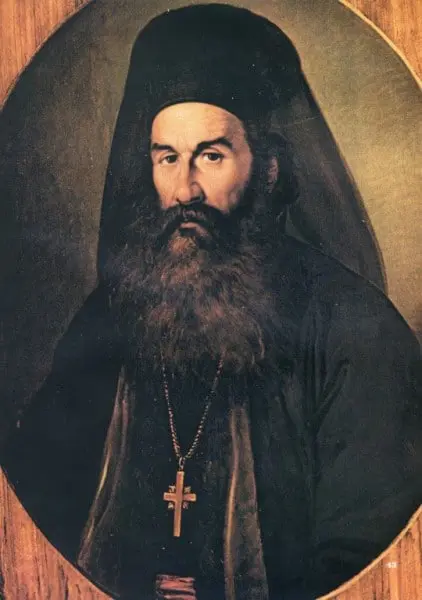
The name of Palaion Patron Germanos may not be the first that comes to mind when one recalls the Greek War of Independence — but he was the one who blessed the uprising.
Germanos III, of Old Patras, was the Orthodox metropolitan who raised the flag of the Greek Revolution at Agia Lavra Monastery on March 25, 1821.
Historians believe that the Metropolitan first met with the chieftains at the Kalavryta monastery on March 13.
Yet March 25 was chosen so that the day of the declaration of war coincided with the feast of the Annunciation of the Virgin Mary.
The Greek people of the time wanted to connect the second-most important figure of Orthodoxy, the Panagia, with the declaration of the Greek War of Independence.
Today, the feast of the Annunciation of the Virgin Mary is inextricably linked with the 1821 Greek Revolution against Ottoman rule.
Palaion Patron Germanos
The Old Patras Metropolitan was born Georgios Gozias (or Kozias) in Dimitsana, Arcadia, on March 25, 1771. His father, Ioannis, was a jeweler.
He went to school in his hometown and then at Argos, where he became ordained and served as deacon to Metropolitan Iakovos.
Germanos left his home to study theology in Smyrna in 1797, where he was employed at the Bishopric by Metropolitan Grigorios.
When Grigorios became Patriarch the same year, he took Germanos with him and promoted him to Archdeacon of the Patriarchate.
Germanos served as Archdeacon from 1800 to 1806 and then as Protosyngellos at the Metropolis of Cyzicus.
In 1806, Germanos was elected Bishop of Patras in 1806, and his charismatic personality soon elevated him to the seat of the Metropolitan of Patras.
In 1815, Germanos was appointed a Holy Synod member in Constantinople, where he stayed for three years.

Germanos joins the Filiki Eteria and raises the flag of revolution
Upon his return to Morias — as the Peloponnesian peninsula was called then — Germanos was initiated into the Filiki Eteria (the “Society of Friends” secret revolutionary organization).
He was introduced to the members of Filiki Eteria by Ioannis Vlassopoulos, Consul of the Russian Empire at Patras.
The Patras Metropolitan started a campaign to raise money for the Greek War of Independence.
At the secret assembly of Vostitsa, which took place from January 26-30, 1821, Germanos expressed reservations about any immediate revolutionary action and conflicted with Papaflessas.
Papaflessas wanted the war to start right away, but the Metropolitan was more cautious, even calling Papaflessas “superficial and outrageous” in a fit of rage.
Germanos proposed that the Greeks should first send people to Russia and other countries in Europe to find out if the larger powers would be in favor of, and support, the Greek struggle.
On Sunday, March 13, 1821, Germanos blessed the new flag of revolution during the liturgy at Agia Lavra Monastery in Kalavryta.
On March 25, the Metropolitan blessed the fighters at Agia Lavra and then hoisted the banner of the Greek War of Independence in Agios Georgios Square at Patras.
Germanos during the war
In December 1822, after the Greek rebels achieved several victories against the Ottomans, the political leaders sent Germanos on a mission to Italy.
The prelate was to ask for support for the Greek cause from the Pope and the European Congress at Verona.
However, the Metropolitan’s stay in Italy was fruitless. Papal representatives asked Germanos for the Greek Church to unite with the Catholic Church under the Pope.
Germanos of course refused, and after that time he was not allowed to travel to Rome. However, he visited other important cities in Italy, such as Bologna and Faenza.
There, he met with prominent diaspora Greeks asking them to lend their support for the Revolution, while making efforts to obtain a loan.
Germanos the conciliator
Upon his return to Greece in June 1824, parts of the homeland had already been liberated, but a minor civil war had already started.
Germanos played a conciliatory role in the feuds among the Greek chieftains who wanted political power for themselves .
The Metropolitan made the mistake of favoring the Achaean chieftains more heavily — perhaps on the grounds of being regional compatriots.
As a result, Yannis Gouras had the Metropolitan arrested in 1825, but Germanos’ contribution to the cause was enough to set him free.
After that incident, he moved to Nafplion, the first capital of modern Greece, where he was appointed member of the Foreign Affairs Committee of the Third National Assembly.
Palaion Patron Germanos passed away on May 30, 1826 and was buried with honors in Nafplion. Later his remains were transferred to his hometown of Dimitsana.
See all the latest news from Greece and the world at Greekreporter.com. Contact our newsroom to report an update or send your story, photos and videos. Follow GR on Google News and subscribe here to our daily email!



